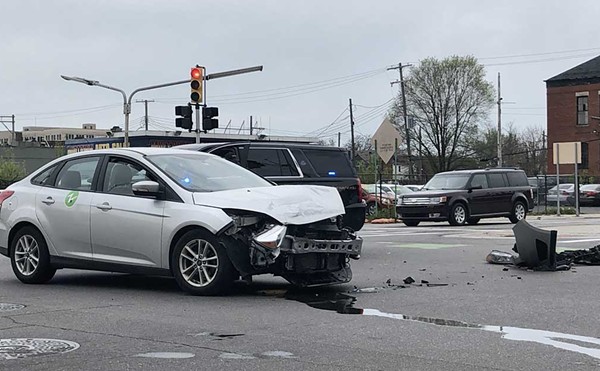A sightseeing cruise along Milan Township’s narrow gravel roads reveals a very special place. While many rural Michigan communities sprout new subdivisions like mushrooms, jarring their quilt works of workmanlike farms with showy trophy homes, this township is resisting the sprawl that’s eating so many other places alive.
Milan Township, directly southwest of its namesake city and about 15 miles south of Ann Arbor, has plenty of reasons to keep fighting. The farms here are big, old, and gorgeous; this time of year proud stands of soybeans, bleached corn and rust-colored wheat stretch toward gaudily autumnal, tree-lined horizons. It’s very quiet here; at sundown the breeze sounds like Mother Nature’s sigh of relief.
After a township election on Feb. 22, many of the township’s 2,000 residents were sighing right along with Mother Nature. Members of the Milan Area Concerned Citizens (MACC) won their David-and-Goliath struggle with two big companies when they passed a referendum that stopped a proposed, gigantic “Intermodal New Vehicle Redistribution Center” in its tracks — or so they thought.
Farms to parking lots
Ann Arbor Railroad (AAR) proposed building the center for General Motors at the Cone Road exit of U.S. 23, a few miles south of Milan. It would have converted most of 1,000 acres of exceptionally lovely, highly productive farmland into an immense rail yard and parking lot, allowing GM to truck in new vehicles from factories in the region and distribute them to its dealers via the national rail carriers farther along AAR’s “short line.” There would be room for 50,000 cars, four times Detroit Metropolitan Airport’s capacity, parked on enough asphalt to cover 35 Meijer’s Thrifty Acres parking lots. Two miles long and a half-mile wide, the facility would have gobbled up one of the area’s largest contiguous parcels of farmland and established the township’s first industrial beachhead. It would have added 1,200 daily semi-truck round-trips on U.S. 23 and 12 more daily mile-long trains to the ones already tying up traffic in downtown Milan.
The simple reason: GM wants to save money. Not only would this new delivery system bring cars to customers more rapidly, it would save on shipping costs by “short lining” vehicles via ARR from the center to any of four national rail carriers farther south. This new access would create a new competitive bidding situation for GM’s national rail needs.
The Milan Township Board’s 3-2 approval of AAR and GM’s proposal triggered the successful repeal effort. One factor was a Michigan Land Use Institute (MLUI) study concluding that although the township would gain roughly $150,000 a year in the deal, after yearly expenses of service to the center the net would be only $35,000 annually.
But the sighs of relief that followed the repeal are turning now into groans of nervousness.
Even though the referendum drew the largest turnout in township history, even though the vote was 54-46 percent in an election involving 750 voters, and even though the township’s new board will have at best only one dependably pro-development member, GM and AAR are not giving up.
They are going back to the new board with a significantly downsized plan even as AAR continues to survey the site and buys some of the property. The two companies are doing this even though the Monroe County Road Commission and Planning Commission, the Southeastern Michigan Council of Governments and the Michigan Department of Environmental Quality have also voted them down.
Understandably, some of MACC’s members don’t like this.
“I am wondering,” says township resident and MACC member Mary Carek, “when it is they will embrace our response. Will it take two referendums? Three? Will that be enough? Do they have to spend $100,000 and then lose?”
Money matters
AAR and its wholly owned subsidiary, AAR Properties, formed to manage the project, spent $85,000 trying to defeat the first referendum — $42.50 per township resident. They outspent MACC 50-to-1.
GM spokesperson Gerald Holmes shrugs off the ratios.
“They (AAR) had to hire people; the community has a lot of volunteers,” he says of the $85,000. “When you have emotion on your side in a community, that carries an awful lot of weight. Big companies always are at a disadvantage in public opinion in those types of things. A company can’t do it any other way, really.”
Carol McCrae-Hokenson, another MACC member, says all that money did make a splash, but not much impression.
“They hired a PR firm, a political consultant, a full-time office staff,” she says. “They got a videographer and produced a video, they had mass mailings with beautiful color pictures, they had yard signs. And we were white-knightless! No one rushed in to be our savior. We called everyone we could think of.”
MLUI, a nonprofit organization in Benzonia dedicated to fighting sprawl, lent an early hand. Conan Smith, then a Land Use Institute staffer, remembers their initial meeting with MACC.
“They were a handful of people who had no clue what they were doing and just wanted this thing to go away,” he recalls. “They did it all the right way: they were honest, open; they went door to door. It is such a noble story. And the people are just delightful to work with.”
But will all of that work really pay off? In late September, MACC wrote General Motors an open letter, asking the company to respect the will of the people. The company responded by letter three weeks later, claiming that federal railroad law could actually make the center a done deal despite local opposition. While hinting that GM would not do such a thing, the letter also characterized the referendum victory as “narrow” and confirmed that AAR is going back to the new township board with a drastically scaled-down project.
“We have eliminated the need for the large inventory of stored vehicles,” the letter reads, “drastically reduced the footprint of the developed area from nearly 600 acres to 260 acres and provided significant areas of woods, wetlands and buffering property that would help preserve the natural setting. It also reduces the number of trucks and trains going in and out of the site.”
Zoning boomerang
Whether this will mollify township residents is now the $85,000 question. Company officials say until a township board meeting in late November they will release no more information, including an economic impact statement that differs markedly from MLUI’s. MACC activists argue that the size of the project is not relevant; saving the township’s master plan is. They fear rezoning could boomerang badly.
Carek says “violating” the master plan for this would set a bad precedent: “We would have to do it for everyone else who asks. Zoning ordinances in those master plans is what we have to hold on to, or we lose development control in our community. This is a pivotal decision; what occurs with this will form a basis for everything in the future.”
Chuck Hall, manager of the proposed project, thinks expansion is in the township’s future, no matter what some citizens say. He characterizes the referendum result as “a 50-50 split” and sees the U.S. 23 corridor as dormant real estate waiting to be developed. Like GM’s Holmes, he asserts the township needs an expanded tax base: many farmers are nearing retirement and the area needs a water system to overcome chronic problems with the quantity and quality of well water.
Referendum supporters say that farming can and will continue, that a new water system is beside the point and that the estimated net increases in township revenue is not worth it. But where center opponents see a phony, unneeded sort of progress, Hall sees destiny.
“You have an active U.S. highway, you have an active railroad, you have hardworking people ready to be employed,” Hall says. He characterizes the area bound by U.S. 23, I-94 and I-275 as “a huge magnet. In a plane, you would instantly be convinced of what I’ve just told you. I’ve never seen a better site than this, truthfully.”
Pointing to the big Cabela’s store that’s now a top state tourist attraction a few exits south of Cone Road, he says, “It’s pretty tough to turn away development when those things start going in motion.”
Which is precisely the point MACC is trying to make. To avoid this slippery development slope, members suggest the center find a “brownfield” area that’s already looking for redevelopment opportunities, such as a site in Willow Run or several others in southwest Detroit. AAR has no use for that; its rail lines don’t go there. And GM claims not using AAR’s unusual access to so many national rail lines would in effect make it surrender the bargaining power it hopes to gain with those lines.
But Smith, now a land use specialist with the Michigan Environmental Council, thinks the sprawling development that so excites Hall is not Milan Township’s inescapable destiny.
“There are lots of politic ways to go about getting what they want without doing what they are doing in Milan,” he says, he says of GM. As to the community, he adds: “I hope they have the strength to stand up to this kind of bullying. If they don’t want it they shouldn’t have to build it.”
McCrae-Hokenson says she remains committed to stopping the center for good. “My mother never taught us to stay quiet if we felt strongly about something,” she says. “So this is a really important thing we are teaching our children: This is tough, it takes a long time, there’s frustration, it’s hard to listen to somebody who may feel differently or have different goals. But if you feel strongly, then you find solutions and don’t just walk away in frustration. You do what it takes to get something done; you are persistent.”
For more information on the Milan Area Concerned Citizens, go to their Web site, www.stopgmrailyard.com.
Jim Dulzo is a Detroit free-lance writer. Send comments to [email protected]




